You cannot simply put the PIR modules in parallel to your camera's input. The PIR modules provide a logic level signal, and putting them in parallel would cause the modules to short circuit each other's output.
In the simplest case, you could use a diode OR circuit to allow the PIR modules to drive the camera input either high or low. Unfortunately, I am having some trouble downloading the camera handbooks so I don't know whether you need to drive the input high or low.
Depending on what the camera needs:
If a low signal means start the camera, use diode OR with the cathodes towards the PIR modules and a pull up resistor on the camera input.
High signal means start the camera, use diode OR with the cathodes towards the camera, with a pull down resistor on the camera input.
Diode OR on Wikipdia.
